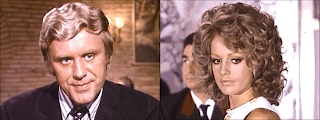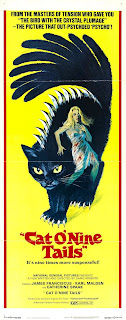The Cat o' Nine Tails is a fairly standard murder mystery, co-written and directed by Dario Argento, who seems determined to set it apart from his previous movie, The Bird with the Crystal Plumage. Unfortunately what he has mostly done is to remove all of the most interesting and distinctive elements. Without Argento's trademark obsessions, and with a far less distinctive mise-en-scène, what's left is mostly a fun but forgettable giallo. There are plenty of twists and turns and an amazing amount of red herrings, but nothing that really gets its fish-hooks into you.
There are still some points of interest, both conceptually and visually, and they mostly have to do with the theme of perception that runs through many of Argento's movies. This one is very concerned with the eye. Arno is blind, and when not wearing dark glasses Karl Malden is very good at suggesting this with a far-away stare. The presence of the killer is always signaled by huge closeups of his retina. A key clue is provided by a photograph which is incomplete; the full version contains a clue at the very edge of the frame - at the edge of perception.

Some bizarre editing also adds to the fun. Most intriguing is the scene towards the start where the break-in occurs. We are watching Arno assemble a crossword puzzle (he has an interesting braille device for doing so) when suddenly we start getting quick cuts of the break-in in progress. Arno looks alarmed and goes to check on Lori (the young girl under his care - we never find out the precise nature of their relationship) before opening the window and "looking" out. His apartment overlooks the Institute - but of course he cannot see anything. The killer, having just dispatched the night watchman, looks up just in time to see Arno's shutters closing again.
This sequence strongly implies a psychic vision, as if Arno's lack of sight has opened up other avenues of perception, but it is never referred to again. But it's an interesting first glimps; psychic powers would become important in some of Argento's later movies.
That relationship between Lori and Arno (who she called Cookie "because he's sweet") is vaguely troubling. Arno says that he has no relatives and she has no parents so they need each other. Is he her uncle, the brother of one of her dead parents? He's been blind for 15 years and she is well under 15 eyars old; who decided that a blind bachelor would be the best person to raise a young girl? There's a lot of physical affection between them, most of it from him; it could all be seen as innocent, but later in the movie we find out that two other characters who are father & daughter by adoption are in a sexual relationship.

It grows even more troubling when you look at Dario Argento's strange screen relationship with his oldest daughter Asia (who was not yet born when Cat o' Nine Tails was made), and it certainly adds something disturbing to the movie.
There are red herrings galore, and almost every character is a suspect at one point or another. The chief suspect, almost from the beginning, is Dr. Braun, a German scientist who is blunt, rude and (it is eventually revealed) homosexual. Gay characters tended to be villains in movies like this, and when the idea of the killer having a chromosonal imbalance (the dreaded XYY, which had already been dragged out in movies like Twisted Nerve) is revealed the audience is lead to believe that Braun is the most likely culprit. However the movie presents its gay characters with more respect than is normal in a movie of its vintage, as was the case with the gay art dealer in The Bird with the Crystal Plumage. They are still clichés, but at least they are sympathetic clichés.
The cinematography is by Erico Menczer, who is a craftsperson where Bird cinemotographer Vittorio Storaro is an artist. There are still some cool shots of staircases, and the camera prowls restlessly in some scenes, but the startling compositions of the earlier movie are missed.
Fortunately the soundtrack by Ennio Morricone is top-notch. Working with orchestrator Bruno Nicolai, as he usually did when scoring a giallo, Morricone provides a score driven by an ominous pulsing bassline that helps to propel the movie forward. A good amount of the movie's atmosphere is provided by this score.
The acting is good throughout. Karl Malden is great fun as Arno, and James Franciscus is solid as reporter Giordani. Eurohorror mainstay Rada Rassimov has a good role the fianceé of one of the victims, though Catherine Spaak's role as the daughter of the Institute's head is under-written, though she does get to drive like an absolute maniac in one terrific scene. Best of all is Horst Frank, clearly relishing his role as Dr. Braun. Spaak and Horst also have amazing early '70s hair.

One big downside to the movie, though, is that the main characters are basically nosy bystanders. In almost every other Dario Argento movie, the protagonist is inexorably drawn to the murders so that it becomes an obsession. In this case we have a reporter trying to get a story and a guy who "likes puzzles". The personal involvement is deeply missed.
The other main downside, other than the lack of visual splendour, is that the murder setpieces are not very interesting. Apart from one great scene involving murder by train (which has a great cynical topper when the reporters abandon photographing the gruesome body to concentrate on a starlet who has arrived on the same train) they are mostly a series of unconvincing garrottings. Some murders even happen off-screen. Given that the murder scenes are where Argento's movies usually excel, this is very disappointing.

The movie is also quite frigid, possibly because Argento usually does express sex through violence in his movies. There is one sex scene, and it's startlingly cold and unerotic. This might be partially because there's no obvious chemistry between James Franciscus and Catherine Spaak, but it's also filmed in a startlingly cold manner. I suspect that Argento simply had no idea how to film a normal sex scene.

I have to say, though, that the ending is wonderful. It takes place on a rooftop, with both of our heroes individually confronting the killer. I won't give it away except to say that it refuses to play it safe, with at least two characters left with an ambiguous fate. There seems to be an implication that with all the different cans of worms that Arno and Giordani have opened, even the apprehension of the killer won't contain the chaos that has been unleashed.
If you compare Cat o' Nine Tails to a giallo from, say, Umberto Lenzi or Sergio Martino, it looks pretty good. If you compare it to the movie Argento had just made, and to the other gialli he made in the 1970s, it looks pretty weak. It's all a matter of perception.


Terrific review Pearce - it is certainly the least distinctive of the animals trilogy and presumably was going for a mainstream approach.
ReplyDelete